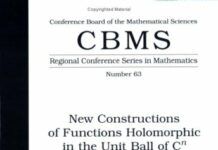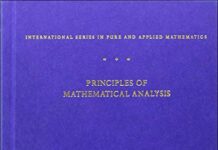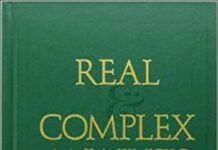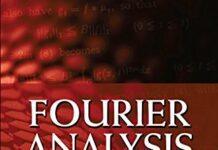
Ebook Info
- Published: 1996
- Number of pages: 191 pages
- Format: PDF
- File Size: 8.63 MB
- Authors: Walter Rudin
Description
Walter Rudin’s memoirs should prove to be a delightful read specifically to mathematicians, but also to historians who are interested in learning about his colorful history and ancestry. Characterized by his personal style of elegance, clarity, and brevity, Rudin presents in the first part of the book his early memories about his family history, his boyhood in Vienna throughout the 1920s and 1930s, and his experiences during World War II.
Part II offers samples of his work, in which he relates where problems came from, what their solutions led to, and who else was involved. As those who are familiar with Rudin’s writing will recognize, he brings to this book the same care, depth, and originality that is the hallmark of his work.
User’s Reviews
Editorial Reviews: Review “It is a real pleasure to read this book and to admire the charming personal style we have come to know from Rudin’s textbooks, monographs and articles. The book is strongly recommended not only to analysts, but also to all mathematicians as well as historians.” —- European Mathematical Society Newsletter”Of noteworthy significance.” —- Zentralblatt MATH”With this memoir, Rudin gives the entire mathematical community a chance to make his acquaintance both mathematically and personally, and a very worthwhile acquaintance it is. The biographical section … is fascinating … It’s what the literary critics call “a good read” … this book is a delight to read and will also help to inspire and guide young analysts in the path of wisdom. You will not want to miss a single page of it … recommend it to everyone.” —- Mathematical Reviews
Reviews from Amazon users which were colected at the time this book was published on the website:
⭐I took two semester courses from Professor Rudin at U of Wisconsin in the early 1960s. I also knew his wife, another great mathematician, Mary Ellen Rudin. Once they invited me to their Frank Lloyd Wright-designed house when they entertained a visiting lecturer who had a grad student doing research similar to mine. They were charming hostsAll that aside, I had no idea how interesting and dangerous the first 24 years of his life were, documented lovingly and told in a matter-of-fact manner.The last part of the book gets heavily into mathematics. It’s really two books.
⭐great book
⭐I learned from Rudin’s math books when I grew up, starting with”Baby-Rudin”, and I got hooked. Since then I have taught from almost everyone of them.— Not this one though! This book is different. It does have math though, but at the same time, in the math part[the second half of the book], Rudin surprises you by letting you look behind the curtain. You are let in on how the author, the mathematician Rudin, arrived at some of his theorems. Enlightening!The early parts of this fascinating book recounts Walter Rudin’s childhood in central Europe[Vienna], how he escaped to the US, with his life, as Hitler’s armies, and the fire of anti-semitism, engulfed Europe in the years up to the second World War. The last ship sailing, at the eve of WWII, from Europe was like an ark. Mount Ararat was America.A well meaning reviewer writes on the back-cover to the book as follows: “…Rudin’s colorfulhistory, … his experiences…”.— Well it is more than that!Another book,[a somewhat different one, from a slightly earlier period, but still the theme of Europe then, and escape…] starts: …”This book is to be neither…, and least of all an adventure, for death is not an adventure to those who stand face to face with it…”
⭐Walter Rudin, Autor der inspirierenden Lehrbücher “Principles Of Mathematical Analysis“, „Real and Complex Analysis“ und „Functional Analysis“, verfasste den vorliegenden Text zunächst als private Geschichte seiner Familie, um die Erinnerungen an ihre europäischen Wurzeln und ihren erzwungenen Exodus, soweit sie ihm noch präsent waren, für Kinder und die stetig wachsende Schar von Enkeln, zu erhalten. Einige Kopien fanden den Weg zu Freunden, die Rudin überzeugten, seine Erinnerungen fortzuschreiben, insbesondere zu seinen Erfahrungen mit verschiedenen Gebieten der Mathematik, die sich in der Nachkriegszeit rasant entwickelten. Schließlich wurde er eingeladen, das Buch in der Reihe ‘History of Mathematics’ der AMS erscheinen zu lassen.Walter Rudin, geboren 1921 in Wien, wuchs in der geordneten Welt einer gutbürgerlichen jüdischen Familie auf, zu deren Leben Sommerferien in Bad Aussee oder Italien genauso selbstverständlich dazu gehörten, wie der Besuch des Gymnasiums (Realschule). Das endet mit dem sogenannten „Anschluss“ Österreichs 1938 und den damit in Kraft tretenden Nazi- Rassengesetzen; vorsorglich wurden Walter und seine Schwester Vera in die Schweiz geschickt, wo sie getrennte Schulen besuchen, die Eltern folgen wenig später – nach den Ereignissen der ‘Kristallnacht’. Aber damit beginnt der Exodus erst, der den Autor und seine Familie durch Frankreich und nach England führt, hier leistet er Militärdienst in der Navy.Nach dem Ende des Krieges, führt Rudins Weg in die USA, hier ist die Familie wiedervereint, und nun kann er sich wieder der Mathematik widmen. An der Duke University promovierte er 1949 bei John J. Gergen, und wird danach C.L.F. Moore Instructor am MIT. Hier fand er für einen Kurs ‘Advanced Calculus’ kein geeignetes hinreichend modernes und präzises Lehrbuch, sein Department Leiters riet ihm „Schreiben Sie selbst eines…“ — daraus entstanden die ‘Principles’, die 1952 bei McGraw- Hill erschienen – heute oft liebevoll einfach ‘Baby Rudin’ genannt. Es folgte eine Stelle als Assistent Professor in Rochester, schließlich erhielt der Autor eine dauerhafte Professur in Madison.Der zweite Teil umfasst Beispiele von Arbeiten des Autors, wobei solche Aspekte betont werden, die beleuchten, woher das Problem stammt, wo seiner Lösung ggf. hinführten, und wer in die ‘Affäre’ involviert war. Darunter sind u.a. Anmerkungen zu Banach Algebren, einem Gebiet, das wesentlich von Gelfand’s Arbeit (1941) beeinflusst wurde, die erst Ende der 40iger Jahre in den USA in Form „verschmierter purpurner Kopien“ bekannt wurde, und einem ‘Mistake’ in einer Arbeit von J. Dieudonne.
⭐
Keywords
Free Download The Way I Remember It (History of Mathematics, V. 12) 1St Edition in PDF format
The Way I Remember It (History of Mathematics, V. 12) 1St Edition PDF Free Download
Download The Way I Remember It (History of Mathematics, V. 12) 1St Edition 1996 PDF Free
The Way I Remember It (History of Mathematics, V. 12) 1St Edition 1996 PDF Free Download
Download The Way I Remember It (History of Mathematics, V. 12) 1St Edition PDF
Free Download Ebook The Way I Remember It (History of Mathematics, V. 12) 1St Edition




